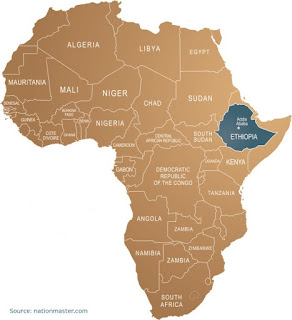Anthropogenic Food Insecurity in Ethiopia
Last week, I highlighted the role that global natural phenomena play in influencing Ethiopia’s rainfall patterns. However, there are other factors putting pressure on Ethiopia’s food supply and whilst not all directly water based, it is important to have a complete understanding of the challenges facing Ethiopia’s food and water relationship. This week I’ll be looking at the impact of general warming, the long-term decline in precipitation experienced in parts of Ethiopia and the significance of the nation’s rapidly growing population.
Ethiopia, as with the rest of the globe, is experiencing anthropogenic warming and an average one-degree temperature rise is expected in the imminent future (see Figure 1). It is likely that this rise will result in the intensification of the natural cycles that I discussed last week, with rainfall events becoming more extreme, but less frequent, with a 40% increase in the frequency of droughts. This will exacerbate both periods of drought and the heavy rains, creating an ever more challenging environment for rain-fed agriculture, which, as highlighted last week, sustains the vast majority of agricultural production in within Ethiopia. Indeed, as Allan and Brian (2008) suggest, adapting to the changes in precipitation that will occur due to global warming is likely to be one of the most significant hurdles facing humanity. In Ethiopia, like other nations within Sub-Saharan Africa (SSA), this challenge is already presenting itself as rising temperatures are intensifying the impacts of recent droughts through increased evapotranspiration. Indeed, of equatorial Africa, Ethiopia is suffering the greatest levels of food insecurity.
One area of agricultural production likely to be particularly affected by rising temperatures is Ethiopia’s coffee production. Coffee is second only to oil in its value as a globally traded commodity and Ethiopia is the 5th largest exporter of Arabica coffee, regarded as one of the highest quality coffee types. Coffee accounts for one-third of Ethiopia’s total export income and over 60% of its foreign exchange income. Importantly, 96% of Ethiopia’s coffee originates from small-holding farms and as a result, approximately 15 million Ethiopians are employed in the coffee industry, from growing to transporting the beans. The majority of the beans are grown in the South Western highlands where, as can be seen in Figure 1, temperature increases are likely to reach one degree or more. This is likely to have a significant impact on coffee yields as temperatures outside of the 18 to 21-degree range will substantially decrease yield and quality. On top of this, the Hypothenemus hampei, or coffee berry borer beetle, whose population growth is linked to temperature, is a coffee destroying pest that wasn’t present in Ethiopia before 1984 but is now completing up to two generations per seasons. Climatic warming in Ethiopia is evidently having far-reaching consequences for agricultural production and the economic effects of reduced high-value commodity yields are likely to exacerbate problems of food security, as I’ll be discussing in the coming weeks.
 |
| Figure 1: Temperature increases across Ethiopia predicted to 2039 based on observations from 1960 to 2009 |
Alongside temperature increases, Ethiopia has experienced a 15 to 20% fall in spring and summer rainfall since the 1970s. The summer rains, in particular, have declined from an average of 501.7mm in the period 1971 to 1990 to a 431.2mm average in the years 1991 to 2010, a fall of over 70mm. Further falls of almost 90mm are predicted by 2054. Figure 2, from the US Geological Survey (2012) offers a visual representation of predictions of rainfall patterns across Ethiopia’s three rainy seasons up to 2039 based on existing trends. Not only have the overall rainfall levels fallen, but rainfall receiving areas been contracting since 1960 (see Figure 3). Figures 3a and b use a 500mm threshold as this level of rainfall will allow for agricultural production. A 900mm threshold for Figure 3c was used as it correlates with long cycle crops. Figure 3a shows a 16% contraction in the Belg rains, endangering the densely populated regions in SNNPR and Oromia, with a further 16% contraction predicted. Figure 3b displays the recent and predicted future contraction of the Kiremt rains, with the expected affected areas home to 12.6 million Ethiopians. Figure 3c highlights an even more worrisome trend, with 20.7 million people in the affected regions. Finally, Figure 3d focuses on the contraction of rainfall over pastoral land, which requires 250mm of rainfall, where 7 million people inhabit the predicted affected areas.
 |
| Figure 2: Rainfall changes across Ethiopia predicted to 2039 based on observations from 1960 to 2009 |
This retreat of suitable agricultural and pastoral areas due to retreating rainfall is exposing millions of people to serious food insecurity. 65% of the at-risk population are dependent on agricultural production, with the remainder relying on pastoral livelihoods. However, it is the combination of worrying rainfall patterns and population growth that is causing the current crisis. Between 1990 and 2010, Ethiopia’s population grew by 68% to 90.9 million and is now almost 108 million (see the growth by region in Figure 4). The correlation between areas with the most rapidly increasing population and regions seeing diminishing rainfall is putting pressure on food production, particularly as virtually all arable land is already being utilised for agricultural production.
 |
| Figure 4: Ethiopian population growth by region 1990 - 2010 |
When the (probably) anthropogenically induced challenges facing food production in Ethiopia that I’ve discussed this week are put in the context of the natural variations explored in my last post, a worrying picture of Ethiopian food security emerges. The situation, having been worsening for decades, has reached crisis point in recent years, with half a million more Ethiopians receiving food aid each year. In light of this, in the coming weeks I’ll be looking at the impacts on food availability of Ethiopia's struggling agricultural production.



Comments
Post a Comment